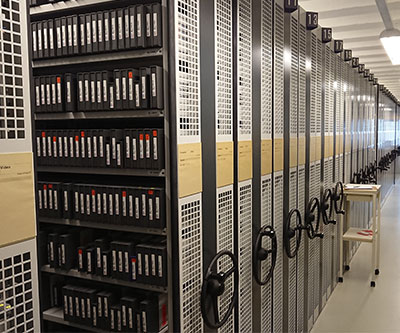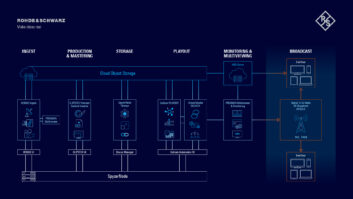Based in Potsdam and Frankfurt, the German broadcasting archive – Deutsches Rundfunkarchiv (DRA) – is one of the oldest parts of national broadcaster, ARD. A not-for-profit organisation, it has been archiving and documenting historically important audiovisual media since 1952. The archive is a treasure trove of German cultural history, including broadcasts made before 1945, as well as the GDR television and the GDR radio until 1991.
Over many decades, DRA has developed its historical holdings with scientific know-how and by using the latest technologies for their digitisation. For today’s and tomorrow’s broadcast users, DRA makes its archive contents available in databases that meet the highest technical and documentary standards.
DRA archive content can be seen and heard on public broadcasters and commercial broadcasters. Similarly, it is used in museums, memorials or cultural events, whenever you encounter pictures and sounds from German history.
Jens Wangenheim, Datendienste, IT und Technik at DRA discusses the role that the R&S Venice server platform plays at the archive.
Jens, what role does Venice fulfil at DRA?
Venice provides a bridge between our editing VTRs and the workstations running file processing software. We use it to ingest Betacam SP, Digital Betacam and MPEG IMX tapes (sometimes even 1-inch Type B tapes, Umatic and VHS). Using Venice, the operators cut, trim and merge the resulting files, before transcoding them to our archive formats.
At the other end of the workflow, we use Venice to playout video files back to tape or DVD for customers that prefer those media types.
Thanks to the broad diversity of formats and codecs that it supports, we also use Venice to convert our video files to different formats for our customers and to recode video files delivered from external service providers to match our archival format needs.

Was there a big challenge that you needed to meet when you started to use Venice?
The big challenge we needed to meet was to transfer our extensive tape-based video stock to a file-based video archive. We wanted a video server system capable of capturing at least four independent channels simultaneously with a variety of output formats/codecs. Furthermore, it was important for us to invest in a server platform that is open to data interchange with third-party vendor systems.
What attracted you to the Venice server platform?
Already, we had bought a Fuze workstation from Rohde & Schwarz and were very happy with it. When we investigated the market for multi-channel video ingest servers Venice stood out with some striking features: a wide selection of codecs, an open file system – not proprietary/hidden, and it is easy to connect to standard workstations. As we knew Spycer from our Fuze and another Workstation (Avid MC), we were confident of maintaining a convenient file management architecture.
Has Venice enabled any new efficiencies in your workflow?
Venice has provided the opportunity to stay in the tape-based world with one leg and to step into file-based workflows with the other one. Due to its option to directly capture on the desired format, we often avoid additional transcoding processes. And thanks to its fast processing speed, we are able to save time when re-encodings are required. Also, due to its trans-wrapping feature, file conversion is boosted even more and happens without any quality loss when remaining in the same format/codec.
What features and facilities of Venice do you like best?
There are several features that we appreciate most:
– Several nearly independent workstations in one unit (or at least several simultaneous processes available – Ingest/Playout/Transcode)
– Very reliable operation, almost no crashes
– A wide variety of formats/codecs, fast transcoding, and smart trans-wrapping.
How does Venice help DRA to build a stronger business?
The variety of video formats/codecs enables us to fulfil the needs of our customers/users.
Venice has implemented the special MXF-profiles specified by the IRT and ARD + ZDF. We can deliver specification compatible formats required by the broadcast stations quickly and easily.
As our stock material is transferred into the file-based world, it becomes easily accessible for our documentalists, and broadcast stations can transfer programme contributions via networks. And last, but not least, science facilities or cultural institutes can do research more easily.







